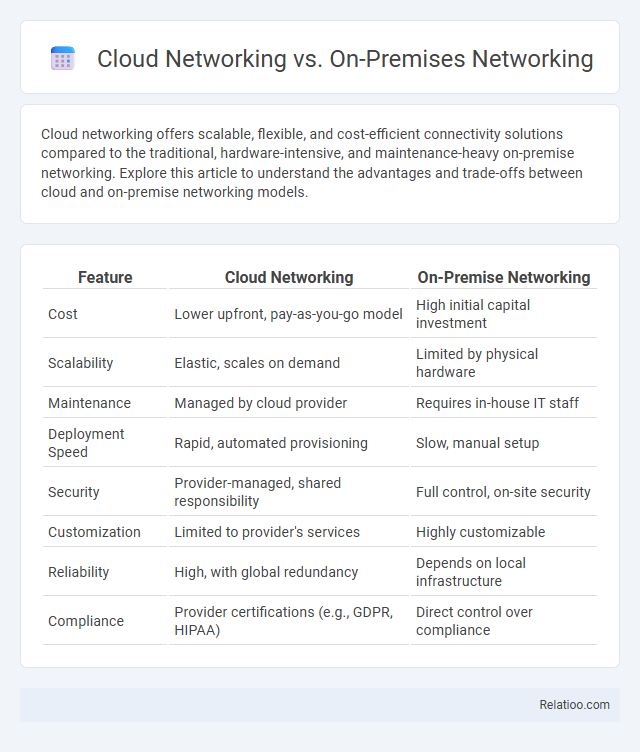Cloud networking offers scalable, flexible, and cost-efficient connectivity solutions compared to the traditional, hardware-intensive, and maintenance-heavy on-premise networking. Explore this article to understand the advantages and trade-offs between cloud and on-premise networking models.
Table of Comparison
| Feature | Cloud Networking | On-Premise Networking |
|---|---|---|
| Cost | Lower upfront, pay-as-you-go model | High initial capital investment |
| Scalability | Elastic, scales on demand | Limited by physical hardware |
| Maintenance | Managed by cloud provider | Requires in-house IT staff |
| Deployment Speed | Rapid, automated provisioning | Slow, manual setup |
| Security | Provider-managed, shared responsibility | Full control, on-site security |
| Customization | Limited to provider's services | Highly customizable |
| Reliability | High, with global redundancy | Depends on local infrastructure |
| Compliance | Provider certifications (e.g., GDPR, HIPAA) | Direct control over compliance |
Introduction to Cloud Networking and On-Premise Networking
Cloud networking leverages virtualized resources hosted in data centers to provide scalable, flexible, and cost-efficient connectivity solutions, eliminating the need for physical hardware management. On-premise networking relies on dedicated hardware and infrastructure controlled within an organization's facility, offering greater control, customization, and security tailored to specific business requirements. Network architecture decisions between cloud and on-premise impact operational expenses, scalability, and maintenance demands, making the choice crucial for optimizing IT performance and resource allocation.
Key Differences Between Cloud and On-Premise Networking
Cloud networking offers scalable, flexible infrastructure managed by third-party providers, reducing the need for physical hardware and on-site maintenance. In contrast, on-premise networking requires organizations to invest in and maintain physical servers, networking equipment, and security protocols internally. Key differences include deployment speed, cost structure, scalability, and control over network configurations and data security.
Cost Comparison: Cloud vs. On-Premise Networking
Cloud networking typically reduces upfront capital expenses by eliminating the need for physical hardware and infrastructure, offering a pay-as-you-go pricing model. On-premise networking requires significant initial investment in equipment, maintenance, and ongoing operational costs, which can lead to higher total cost of ownership over time. Your choice impacts both short-term budgeting and long-term financial planning based on scalability, control, and maintenance considerations.
Scalability and Flexibility
Cloud networking offers unparalleled scalability by allowing your resources to expand or contract seamlessly based on demand, providing flexibility that traditional on-premise networking struggles to match due to fixed hardware limitations. On-premise networking provides control and security but often requires significant investment and time to scale, making it less adaptable to rapid changes. Network infrastructure overall should be evaluated for its ability to support dynamic workloads and evolving business needs, with cloud solutions typically leading in flexibility and scalability compared to on-premise setups.
Security Considerations
Cloud networking offers scalable security features such as built-in encryption, continuous monitoring, and automated threat detection, making it easier to protect data without significant infrastructure investment. On-premise networking provides full control over security policies, allowing customizable, hardware-based protections but requiring your organization to manage complex updates and physical safeguards. Balancing these options, your network security strategy must address data sensitivity, compliance requirements, and the resources available for ongoing threat management.
Performance and Reliability
Cloud networking offers scalable performance with dynamic resource allocation and high reliability through distributed data centers and automatic failover mechanisms. On-premise networking provides consistent low-latency performance and full control over hardware but may face limitations in scalability and redundancy compared to cloud solutions. Traditional network setups prioritize customized configurations and localized control but often require significant maintenance to ensure reliability and optimal performance.
Maintenance and Management
Cloud networking reduces maintenance burdens by offloading infrastructure updates and security patches to service providers, ensuring your network stays current without manual intervention. On-premise networking demands dedicated IT staff for ongoing hardware maintenance, software updates, and troubleshooting, increasing operational complexity and costs. Hybrid network solutions blend these approaches, offering customizable management options while balancing control and ease of maintenance.
Compliance and Data Privacy
Cloud networking offers scalable solutions with built-in compliance frameworks like GDPR and HIPAA, ensuring your data privacy is managed through encrypted transmissions and regular audits. On-premise networking provides direct control over data environments, allowing tailored compliance measures but requiring significant resources to maintain up-to-date security standards. Choosing between cloud and on-premise depends on your organizational needs for compliance, with hybrid approaches often balancing data sovereignty and operational flexibility.
Use Cases and Industry Applications
Cloud networking offers scalable, cost-effective solutions ideal for industries requiring remote access and rapid deployment, such as healthcare and e-commerce. On-premise networking provides enhanced security and control, essential for financial institutions and government agencies handling sensitive data. Hybrid networks combine both approaches, supporting diverse use cases in manufacturing and enterprise IT where flexibility and compliance are critical.
Choosing the Right Networking Solution for Your Business
Choosing the right networking solution for your business depends on scalability, security, and infrastructure control requirements. Cloud networking offers flexible resource management and lower upfront costs, while on-premise networking provides enhanced security and full control over hardware. Evaluating your organization's data sensitivity, growth projections, and budget will guide you in selecting the most efficient and reliable network architecture.

Infographic: Cloud Networking vs On-Premise Networking
 relatioo.com
relatioo.com